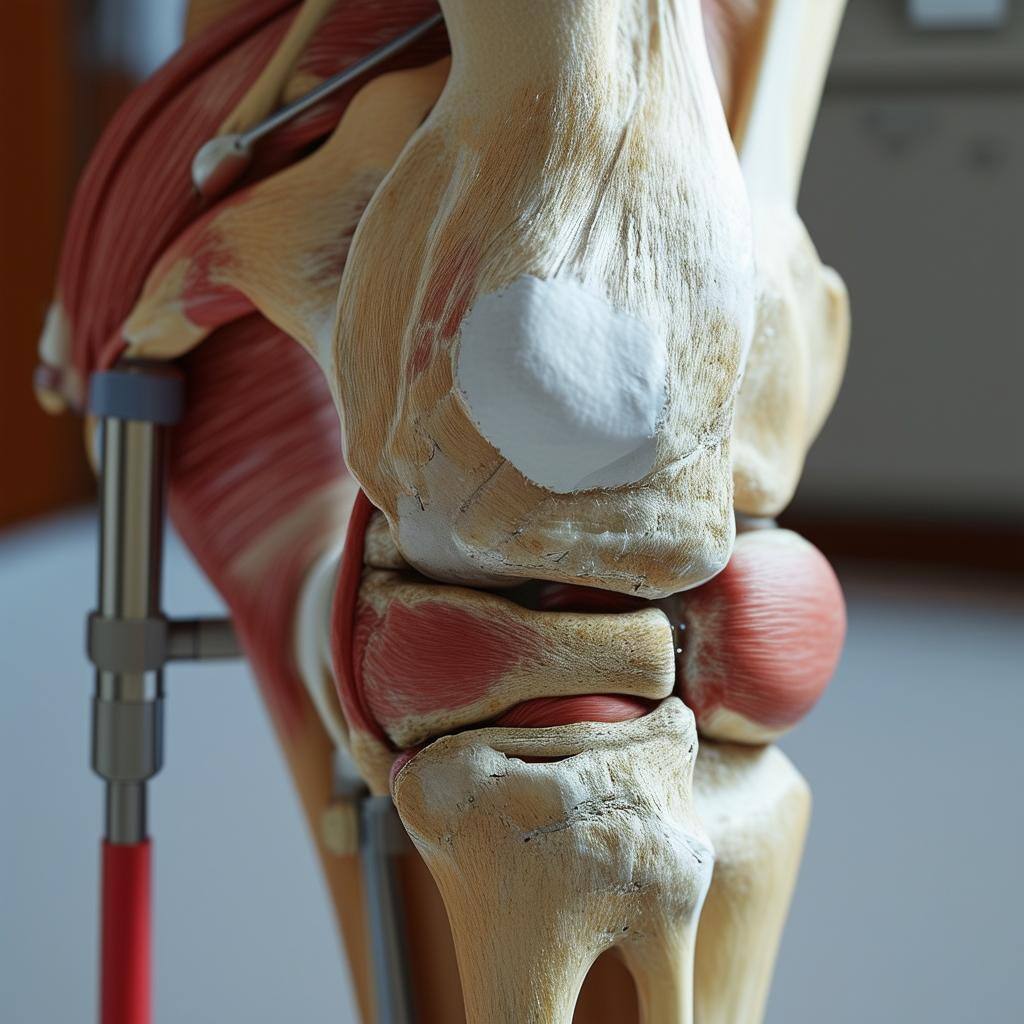

Knee replacement surgery, also referred to as knee arthroplasty, is a transformative treatment for individuals dealing with the detrimental impact of severe knee arthritis or injury. This medical intervention involves the resurfacing of the knee joint, where damaged components are meticulously replaced with sophisticated artificial parts made from durable materials like metal and plastic. These artificial parts are designed to mimic the knee's natural movement and function.
The purpose of this article is twofold: to demystify the intricacies of the knee surgery process and to serve as a comprehensive guide illuminating every phase – from the meticulous preparations required before entering the operating room to the critical post-operative care that follows. For those considering this life-altering procedure, it is essential to grasp not only what occurs during surgery but also how to effectively prepare for it and navigate the recovery journey.
If you’re contemplating whether knee joint replacement is the right path for you, connecting with a top-tier specialist is crucial. Consider scheduling an appointment with a highly qualified doctor through TopDoc to gain personalized advice tailored to your unique health needs.
1. Understanding Knee Replacement Surgery
Knee replacement surgery, also known as knee arthroplasty, is a surgical procedure that treats severe knee damage or arthritis. This operation replaces the damaged surfaces of the knee joint with artificial components made of metal and plastic. The main objective of this procedure is to enhance mobility, lessen pain, and improve the quality of life for individuals suffering from knee ailments.
Types of Knee Replacement Surgeries
There are two main types of knee replacement surgeries:
- Total Knee Replacement (TKR): Involves replacing all three parts of the knee joint - the femur (thigh bone), tibia (shin bone), and patella (knee cap). This procedure is typically recommended for people with advanced arthritis or severe knee damage.
- Partial Knee Replacement (PKR): Also known as unicompartmental knee replacement, it involves replacing only the damaged part of the knee. PKR is usually considered for those with arthritis limited to one area of the knee.
Eligibility for Knee Replacement Surgery
When it comes to eligibility for knee replacement surgery, there are no specific age or weight restrictions. The decision for surgery depends more on an individual’s pain level and disability. Candidates usually have:
- Severe pain that hinders daily activities
- Pain at rest
- Chronic inflammation or swelling that doesn’t improve with rest or medication
- Deformity, such as bowing in or out of your leg
It's important to note that surgery is typically recommended only after conservative treatments like medications, physical therapy, and use of assistive walking devices have failed to provide relief.
Common Reasons for Knee Replacement Surgery
Common reasons for undergoing knee replacement surgery include:
- Osteoarthritis: A degenerative joint disease that wears away cartilage.
- Rheumatoid arthritis: An autoimmune disease causing inflammation of the synovial membrane leading to excessive synovial fluid.
- Post-traumatic arthritis: Arthritis resulting from a severe knee injury.
This comprehensive understanding of knee replacement surgery sets the foundation for discussing the surgical process and what patients can expect from this procedure.
2. The Surgical Process
The Surgical Journey Begins: Anesthesia and Incision
Knee replacement surgery, also known as knee arthroplasty, starts with the administration of anesthesia. Depending on the patient's overall health and the surgeon's preference, this can be either general anesthesia or spinal/epidural anesthesia. The goal is to keep the patient free from pain during the entire surgery.
After the anesthesia takes effect, the surgeon makes a surgical cut just above the knee. This allows them to reach the damaged knee joint.
Damaged Cartilage Removal and Bone Preparation
Next, the surgeon removes the damaged cartilage on both ends of the joint. They also take off a thin layer of underlying bone. By doing this, they prepare the remaining bone surface so it can properly support the new implant.
Implants Positioned to Restore Knee Function
Carefully, metal implants are placed to replace the removed cartilage and bone. These implants recreate the surface of each part of the joint. Sometimes, cement is used to hold them in place. In other cases, they're inserted without cement so that your own bone can grow onto them over time.
In certain situations, surgeons may decide to resurface the underside of your kneecap (patella) by adding a plastic button. However, this step isn't always necessary for everyone.
Spacer Insertion Ensures Smooth Movement
Once all the components are in position, a spacer made of medical-grade plastic is inserted between the metal parts. This acts like an artificial cartilage, allowing your newly created knee joint to move smoothly.
Returning to Consciousness: Procedure Completion
Finally, the surgeon closes the incision with stitches or staples and covers it with a dressing. The entire surgery usually takes around one to two hours. Afterward, you'll be taken to a recovery room where you'll stay until you wake up fully from the anesthesia.
This surgical process offers hope for individuals dealing with severe knee arthritis or damage. It's important to understand that while the surgery itself is crucial, achieving better mobility and less pain also involves preparing for the surgery beforehand and taking care of yourself after the operation.
In the next section, we'll discuss how you can get ready for a successful surgery and ensure a smooth recovery. We'll cover topics such as mental preparation and pre-surgery exercises, giving you an overview of what it takes to prepare yourself for this life-changing procedure.
3. Preparing for a Successful Surgery
Pre-surgery preparation is an essential part of the knee replacement journey, as it sets the stage for a successful operation and recovery. This process involves both physical and mental aspects, designed to ensure that patients are in optimal condition before undergoing surgery.
Comprehensive Medical Evaluation
To start with, a comprehensive medical evaluation is typically required. This includes:
- A thorough review of the patient's medical history
- Physical examination
- Blood tests
- Chest X-ray
- Electrocardiogram (ECG)
These tests help the surgeon identify any potential health issues that could complicate the procedure or recovery.
Managing Medications
Another critical aspect of pre-surgery preparation involves managing existing medications. Patients need to disclose all medications they are currently taking, including over-the-counter drugs and supplements. Some of these may need to be temporarily discontinued before surgery to reduce the risk of complications.
Understanding the Procedure and Recovery
Mental readiness is just as crucial as physical preparation. It's important for patients to understand what the procedure entails, its potential risks, and benefits, and what they can expect during recovery. Knowledge can help alleviate anxiety and promote a positive outlook, which can indirectly aid in recovery.
Pre-operative Exercises
Equally important are pre-operative exercises. A tailored exercise program can help strengthen the muscles around the knee, enhancing stability and mobility after surgery. Here's where physical therapists come into play:
- They design exercise routines focused on improving strength, flexibility, and range of motion.
- These routines often include leg-strengthening exercises such as leg lifts and ankle pumps.
- Regularly performing these exercises before surgery can lead to improved surgical outcomes.
Remember that each person's pre-surgery preparation may differ depending on their overall health status and specific needs. Hence, it's important to follow personalized advice from your healthcare team for optimal results.
The steps discussed in this section not only pave the way for a smoother surgical process but also lay a solid foundation for the post-operative recovery journey.
4. Ensuring a Smooth Recovery Journey
Recovering from knee replacement surgery is a critical phase that demands patience and adherence to medical advice. The recovery period can vary, but here's a typical timeline:
- Hospital Stay: Patients usually stay in the hospital for 1 to 3 days post-surgery.
- Rehabilitation: Begins in the hospital and continues for weeks to months at home or at a rehab facility.
Recovery Timeline
The journey back to normalcy is gradual:
- First Few Days: Focus on pain management, minimizing swelling, and beginning physical therapy.
- Weeks 1-3: Gradual increase in activity with walking aids; wound care is crucial.
- Weeks 4-6: Transitioning from walking aids, increasing exercise intensity.
- Months 2-6: Continuing with outpatient physical therapy, regaining strength and mobility.
Pain Management Techniques
Effective pain control is central to recovery:
- Medications: Prescribed to ease discomfort during the initial weeks.
- Ice and Elevation: Reduces swelling and provides relief.
- Movement: Gentle exercises under supervision help manage pain by improving circulation and strength.
Comprehensive Rehabilitation Program
A structured rehab program significantly improves outcomes:
- Supervised Therapy Sessions: Guidance from physical therapists ensures correct movement patterns and prevents injury.
- Home Exercises: Customized routines support ongoing improvement outside of therapy sessions.
Physical therapists often tailor exercises to each patient's needs, focusing on:
- Regaining knee motion
- Strengthening muscles around the knee
- Improving walking and balance
- Activities of daily living
Adherence to the prescribed rehabilitation plan is key for a successful return to normal activities. Regular follow-ups with healthcare providers monitor progress and adjust treatment plans as needed.
5. Managing Risks and Complications
Knee replacement surgery is a complex procedure, and like any major surgery, there are potential risks and complications that patients should be aware of. While most surgeries go well, it's important for patients to know the signs of any problems so they can get medical help quickly.
Common Complications After Knee Replacement Surgery
Infection
An infection can happen around the cut or in the deeper tissue near the new knee joint. Signs of infection include:
- Fever
- More redness or swelling around the knee
- Warmth around the joint
- Fluid coming from the cut
- More pain or stiffness in the knee
Blood Clots
Blood clots can form in the leg veins when you're not moving much after surgery. Signs of a possible blood clot include:
- Swelling in the calf, ankle, or foot
- Tenderness or redness above or below the knee
- Feeling like your leg is warmer than usual
Minimizing Risk of Infection and Blood Clots
Healthcare providers do several things to lower the risk of problems:
Preventing Infection
- Giving antibiotics before, during, and sometimes after surgery.
- Making sure everything is clean in the operating room.
- Using careful surgical techniques to cause less harm to tissues.
Reducing Blood Clot Risks
- Encouraging early movement—getting patients up and about soon after surgery to increase blood flow.
- Using special devices on the legs to keep blood moving during and after surgery.
- Giving medicine when needed to make the blood thinner and prevent clots.
Patients also have an important part in their own care after surgery by following their surgeon's advice closely. This includes taking prescribed medicine, going to follow-up appointments, and right away telling their doctor about any strange symptoms.
By watching out for possible problems and working closely with healthcare professionals, patients can do a lot to have a safe recovery.
Understanding these risks and how they're handled can help people who are thinking about knee replacement surgery feel more ready for what might happen and how to get better.
Home Modifications and Assistive Devices for a Safe Home Recovery Environment
Creating a safe and accessible home environment is crucial for recovery after knee replacement surgery. Patients need to adapt their living spaces to prevent falls and ensure ease of movement as they regain mobility. Here are practical tips for home modifications and assistive devices:
Home Modifications
- Install Handrails: Consider adding handrails in critical areas, such as alongside stairs, hallways, and especially in the bathroom near the toilet and bathtub or shower.
- Remove Hazards: Clear walking paths of any obstacles like loose rugs, electrical cords, or clutter that could increase the risk of tripping or slipping.
- Adjust Furniture: Rearrange furniture to create wide walkways and remove low-lying items that are hard to see when using walkers or canes.
- Improve Lighting: Ensure rooms and hallways are well-lit, with light switches easily accessible at room entrances. Nightlights in hallways, bathrooms, and bedrooms help prevent accidents during nighttime.
Assistive Devices
- Shower Bench or Chair: A shower bench or chair allows you to bathe without standing for long periods, reducing the risk of slipping in the wet environment.
- Raised Toilet Seat: A raised toilet seat with arms can make it easier and safer to sit down and stand up from the toilet.
- Long-Handled Tools:Sponge: A long-handled sponge facilitates washing feet and legs without bending over.
- Shoe Horn: A long-handled shoe horn helps put on shoes without bending the knee excessively.
- Grabber: A grabber tool assists in picking up objects from the floor or reaching items in high places without strain.
- Slip-Resistant Mats: Place slip-resistant mats under rugs or inside the bathtub/shower to reduce slip hazards.
By integrating these modifications and devices into your home space, you actively contribute to a safer recovery phase post-knee replacement surgery. Ensuring your environment accommodates your healing process not only brings peace of mind but also supports positive surgical outcomes. With each tailored adjustment, patients find more confidence navigating their daily routines while protecting their new knee joint from undue stress or injury.
Long-Term Outcomes and Success Rate of Knee Replacement Surgery
Knee replacement surgery has proven to be a transformative procedure for many, with research indicating high success rates. Success rate is often evaluated in terms of pain relief, improved function, and patient satisfaction.
Pain Relief
A predominant reason for undergoing knee replacement surgery is to alleviate chronic and debilitating pain. It's worthy of note that a significant percentage of patients report substantial or complete relief from pain post-surgery. This results in a marked improvement in their quality of life.
Improved Function
Patients typically experience improved mobility after knee replacement surgery. This includes better range of movement, reduction in stiffness, and the ability to engage in daily activities more comfortably. In fact, many patients regain the capacity to participate in physical activities they previously had to avoid due to knee issues.
Patient Satisfaction
A key indicator of the success rate of knee replacement surgery is patient satisfaction. Studies indicate that a majority of patients express high levels of satisfaction post-surgery. They report enhancements not only in physical capabilities but also overall life satisfaction.
To provide further insight into success rates, it's essential to consider long-term outcomes. A study published by the National Institutes of Health found that:
"About 82% to 85% of artificial knees still function 20 years after the operation."
This longevity demonstrates the effectiveness and durability of knee implants over time.
It's important to remember individual results can vary. Factors impacting long-term outcomes include the patient's overall health, commitment to rehabilitation, weight management and lifestyle habits such as smoking or alcohol consumption.
While knee replacement surgery boasts high success rates, taking an active role in your recovery process plays a significant part in achieving these positive outcomes.
Conclusion
If you're dealing with severe knee pain and struggling with limited mobility every day, and other treatments haven't helped, it may be worth thinking about getting knee replacement surgery. Talking to a qualified orthopedic surgeon is crucial to figure out if this procedure is right for you. Knee replacement surgery is a major medical treatment that can significantly improve your quality of life.
When done on the right patients, this surgery has been proven to:
- Relieve long-lasting knee pain
- Restore mobility
- Enable people to have active and fulfilling lives
After the surgery, taking care of yourself is extremely important for your recovery. This includes following through with rehabilitation exercises and physical therapy as recommended by your healthcare team. Their guidance will help you navigate the healing process with confidence, increasing your chances of a successful outcome.
Many individuals who undergo knee replacement surgery experience a complete turnaround in their daily lives. They regain the freedom to move around without pain, which opens up new opportunities for activities they used to enjoy or have always wanted to try.
If you're considering this life-changing procedure, keep in mind that with the right medical professionals and commitment to post-surgery care, many people have regained their independence and comfort. The road ahead may seem challenging, but the potential benefits of reclaiming an active lifestyle are priceless.
FAQs (Frequently Asked Questions)
What is knee replacement surgery?
Knee replacement surgery, also known as knee arthroplasty, is a procedure in which damaged or diseased parts of the knee joint are replaced with artificial components to relieve pain and restore function.
What is the difference between total and partial knee replacement?
Total knee replacement involves replacing the entire knee joint, while partial knee replacement only replaces the damaged part of the knee. The choice between the two depends on the extent of damage and the patient's specific condition.
Who is a candidate for knee replacement surgery?
Candidates for knee replacement surgery are individuals with severe knee arthritis or damage that significantly impairs their daily activities and quality of life. Eligibility criteria include persistent pain, limited mobility, and failure to find relief through conservative treatments.
What are the common reasons for undergoing knee replacement surgery?
Common reasons for undergoing knee replacement surgery include osteoarthritis, rheumatoid arthritis, post-traumatic arthritis, and other conditions that cause irreversible damage to the knee joint.
What are the steps involved in preparing for knee replacement surgery?
Patients need to undergo a medical evaluation, complete necessary tests, and engage in pre-operative exercises to strengthen surrounding muscles. It is important to follow all pre-surgery guidelines provided by healthcare providers.
What is the expected recovery timeline after knee replacement surgery?
The recovery timeline varies for each individual but typically includes a hospital stay of a few days followed by several weeks of physical therapy. Pain management techniques and comprehensive rehabilitation programs play a crucial role in facilitating recovery.



Comments (0)